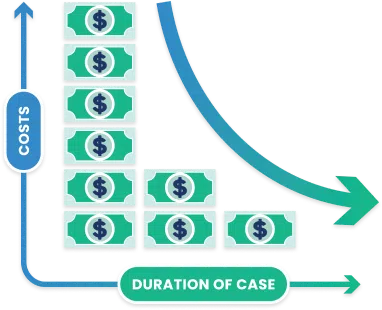Our office trends towards high conflict and high complexity cases, so it makes sense for us to charge hourly fees to remain agile and flexible in the administration of our client’s cases.
We do understand that there are real drawbacks to every system though, and this one is no different.
This page will explain our billable hour system and some common ways it bites us and other firms who use it.
What counts as hourly time?
Billable time:
What specific tasks are billable will depend on the circumstances of your case, but here are some good rules of thumb to go by:
Time is billable if…
it furthers your attorney’s knowledge or understanding of your case. Or is necessary for the execution of the same.
Time is not billable if…
it is applicable to multiple matters, or is general office work, or is administrative in nature.


Hemmat Law conducted the biggest Family Law secret shop ever performed in Washington, assessing 400 organizations to create the most comprehensive look into the state of the Washington family law landscape.

Attorney Fees Calculator
Legal fees can vary widely depending on your unique situation. Our calculator is designed to give you a general estimate based on the details that most often influence costs
The drawbacks of the billable hour system
The billable hour is among the oldest and most well known of the fee structure models for law firms, and it has a bad reputation for being abused by legal practitioners.
This can sometimes be true – any system has the potential to be abused, especially by professionals who operate without transparency – but a large part of the poor reputation comes from a misunderstanding about what time is billed and why.
Clients can be left feeling hurt or taken advantage of under the hourly model, and it’s important to address some of these common pitfalls.
Understanding the Structure of Legal Work:

Almost all legal work (no matter the fee structure) is heavily front loaded:
By the time your attorney files that motion, petition, or memo, 85% of the work is already done.
This means that clients can get hit with huge legal bills with ‘nothing’ to show for it.
When the attorney has done a poor job of communicating this expectation to the client, the client can be understandably outraged, and the relationship can quickly deteriorate.
Things your lawyer may not tell you

Legal research is often in search of negative inferences:
What makes legal research so challenging is that legal practitioners don’t only need to support a position with evidence, but also ensure that there isn’t any case law or facts to disprove it, either.
This means that to do a thorough job of representing our clients, we are often in search of what hasn’t or may not have happened in a case, as much as we are in search for what has.
Especially when facts might appear straightforward to those applying common sense, to a client it might appear like a wild goose chase with their money on the line; But unfortunately the law often has some strange, antiquated and nuanced ways of thinking that have to be considered.

The lawyer’s role is more strategy and research-based than administrative:
Drafting documents, arguing in court, or answering emails is just a tip of the iceberg. The majority of our work is to ‘peer around corners,’ identify opportunities, eliminate possibilities and weigh probable outcomes. A lot of this work is ‘unseen’ by the client, and that disconnect can cause friction, including clients arguing with attorneys over the advice they are given.
But in reality, the fact that we draft documents and appear in court is a byproduct, not the point, of our fundamental duty as advisors.
We are advisors. So long as you are not lying to the court, we will execute whatever fully informed strategy you request. But if we push back, it is usually for a very good reason.

Emotions can be expensive
Family law is one of the most perilous and fraught times of our client’s lives.
At crucial points in our client’s cases, especially in contentious situations, it can be very difficult to
make what is the legally correct, but emotionally unsatisfying decision.
Many clients can end up leaning on their legal team for emotional support. It’s understandable – We learn everything about you, your story and your goals through the course of your case, but we are not therapists.
Some clients can also end up wielding their lawyers like weapons, provoked by anger or frustration against the other party.
Although we understand that emotions can run high in Family Law cases, it has to be said that being reactive to emotions is one of the biggest drivers of legal costs when combined with the billable hour.
In a nutshell: Hate has driven more legal expenses than any caselaw throughout history. Justified or not.



















